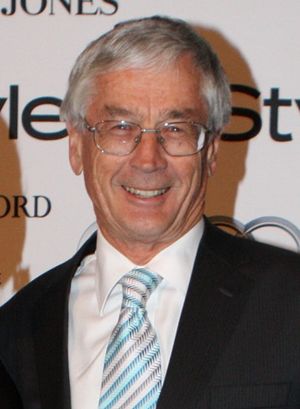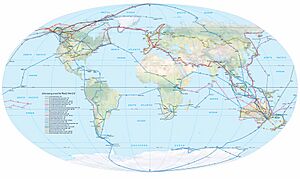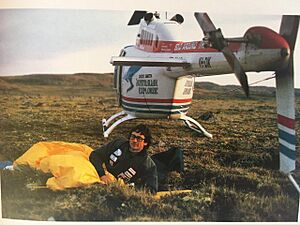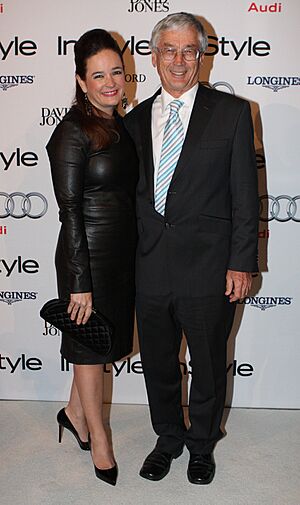Dick Smith (businessman) facts for kids
Quick facts for kids
Dick Smith
|
|
|---|---|

Smith in 2013
|
|
| Born |
Richard Harold Smith
18 March 1944 Roseville, New South Wales, Australia
|
| Education | North Sydney Technical High School |
| Known for | Entrepreneur, aviator |
| Spouse(s) | Philippa Aird McManamey |
| Children | 2 |
| Awards | Companion of the Order of Australia |
Richard Harold Smith (born 18 March 1944) is a famous Australian entrepreneur, aviator, and adventurer. An entrepreneur is someone who starts their own businesses. Smith is known for starting companies like Dick Smith Electronics, Australian Geographic magazine, and Dick Smith Foods.
Smith loves flying and has set many world records in planes and helicopters. He is also a major philanthropist, which means he gives a lot of money to charities and to help protect the environment. In 2015, he received the Companion of the Order of Australia, one of Australia's highest honors.
Contents
Early Life and Scouting
Dick Smith was born in Roseville, New South Wales. As a child, he had some trouble in school. He attended Roseville Public School and later North Sydney Technical High School.
In 1952, at age 8, he joined the Scouts. He was a Cub Scout, a Boy Scout, and a Rover Scout. Scouting taught him about organization and leadership. He said these skills helped him become successful later in life. In 1966, he earned the special Baden-Powell Award.
At age 16, Smith got his amateur radio license. For a few years, he worked as a technician fixing taxi radios.
Famous Business Ventures
Dick Smith Electronics
In 1968, Smith and his fiancée Pip started a small business fixing car radios. They began with only $610. The business was called Dick Smith Car Radios.
It quickly grew into a popular store called Dick Smith Electronics. The store sold all kinds of electronics, like radios and one of the first personal computers. By 1980, he sold the company to Woolworths for $25 million. The stores kept his name for many years but closed in 2016.
Australian Geographic
In 1986, Smith started Australian Geographic. This magazine is like National Geographic but focuses on Australia's nature, culture, and adventures. It became very successful. In 1995, he sold the business for $41 million.
Dick Smith Foods
Smith started Dick Smith Foods in 1999. He wanted to support Australian farmers and food makers. The company only sold food that was made in Australia by Australian-owned companies. All the profits from Dick Smith Foods went to charity.
The business closed in 2019 after giving over $10 million to charities. Smith said it was hard to compete with big international supermarket chains.
Amazing Adventures in the Air
Smith has always loved adventure. He learned to fly in 1972 and became a skilled pilot. He has set many world records.
First Solo Helicopter Flight Around the World
In 1982, Smith became the first person to fly a helicopter around the world by himself. He started in Fort Worth, Texas, in his helicopter, a Bell Jetranger. The journey took him over a year to complete.
He flew across the Atlantic Ocean and was greeted by King Charles III (who was a prince at the time). He had to land on a ship in the ocean to refuel because he wasn't allowed to land in the Soviet Union. He finished his amazing trip on 22 July 1983.
Flying to the North and South Poles
Smith was the first person to fly a helicopter to the North Pole. He made it on his third try in 1987.
In 1988, he flew a special plane, a Twin Otter, from Australia to the South Pole. He then flew to the North Pole before returning home. This made him the first person to fly around the world while landing at both poles.
Other Record-Breaking Flights
- First balloon trip across Australia: In 1993, he and his co-pilot John Wallington flew a hot-air balloon all the way across Australia.
- Around the world again: In 1995, he and his wife Pip flew a helicopter around the world from east to west.
- Flying over Mount Everest: In 1991, he flew his plane over the top of Mount Everest, the world's highest mountain.
Fun Stunts and Challenges
Dick Smith is also known for his fun and clever stunts.
On April Fool's Day in 1978, he pretended he was towing an iceberg into Sydney Harbour. He claimed it would be a new source of fresh water. It turned out to be a large object covered in white plastic and foam!
In the 1980s, he organized a stunt where a London double-decker bus jumped over 16 motorcycles. This was the opposite of what stuntman Evel Knievel did. Smith decided to ride on the bus during the jump!
Helping Others and Speaking Out
Charity Work
Smith is a very generous philanthropist. He has given millions of dollars to charities like The Salvation Army, Scouts Australia, and the Country Women's Association. He also helped build an orphanage in Afghanistan.
He started the B to B Bash, a yearly car rally that raises money for Variety, the Children's Charity. The event has raised over $200 million for children in need.
Protecting Nature and Finding Lost Animals
Smith cares deeply about the environment and wildlife. In 1989, he offered a $25,000 reward to anyone who could find the night parrot, a bird that people thought was extinct. A year later, a dead one was found, which led to searches that finally found living night parrots in 2013.
A 20-million-year-old fossil of a koala relative was named Litokoala dicksmithi in his honor. This was to thank him for supporting science and fossil research.
Population and a Fair Go
In recent years, Smith has focused on the issue of population growth. He believes that Australia's population is growing too fast, which could harm the environment. He made a documentary called Dick Smith's Population Puzzle to share his ideas.
He started the "Dick Smith Fair Go" group. The group asks for a "fair go" for all Australians. It supports policies to manage population growth and reduce the gap between rich and poor people.
Awards and Honors
Dick Smith has received many awards for his business success, adventures, and charity work.
| Year | Awards and distinctions received by Dick Smith |
|---|---|
| 1966 | Baden-Powell Award, Scouts Australia |
| 1986 | Australian of the Year, National Australia Day Council |
| 1992 | Lindbergh award, Lindbergh Foundation |
| 1997 | Australian Living Treasure, National Trust of Australia |
| 1999 | Officer of the Order of Australia |
| 2000 | Adventurer of the Year, Australian Geographic Society |
| 2001 | Centenary Medal, Australian Government |
| 2013 | Inducted into the Australian Aviation Hall of Fame |
| 2015 | Companion of the Order of Order of Australia |
| 2018 | Australian Father of the Year Award, The Australian Father's Day Council |
Images for kids





